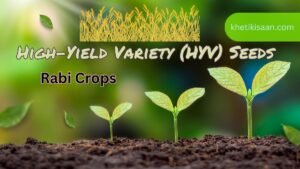Kharif crops—also called monsoon crops—hold a prominent spot in Indian farming. Planted when the southwest monsoon kicks in (usually in June), they’re ready to harvest during autumn, mainly from September to November. The main Kharif crops are rice, maize, cotton, jowar & pulses. These crops play a significant role in feeding India & boosting farm production. Their growth depends a lot on the rainy season, which means their success hangs on rainfall patterns. Because of this, farming these crops can be both a good chance & a big challenge since weird weather can mess up the harvest & profits.
High-yield variety (HYV) seeds are super helpful in growing more Kharif crops in India. These seeds are tweaked to give way better yields than old-time seeds. Using HYV seeds has really changed how many crops get produced, often meaning farmers earn much more. HYV seeds grow faster, fight off pests better & can handle different weather conditions nicely. For farmers aiming to get better yields, these seeds are a great pick. By using HYV seeds for Kharif crops in India, farmers can not only grow more but also dodge the risks from pests and diseases that usually mess up plants.
Plus, choosing HYV seeds makes sense money-wise, too. The chance to make more significant profits pushes farmers to pick these seeds more often, helping them live more securely. As India still deals with food security issues, using HYV seeds for Kharif crop farming becomes vital. Knowing how great these seeds are helps farmers make intelligent choices to get the most out of their land without harming nature.
Popular High-Yield Variety Seeds for Kharif Crops in India
High-yield variety (HYV) seeds really help boost the number of Kharif crops that grow in India. Here’s a list of favourite HYV kinds across different plants that farmers may want based on where they’re located and how they farm.
Rice: Top high-yield varieties like IR 64 & Kalinga III are prevalent for growing rice during the Kharif season in India. IR 64 is known for its tremendous yield potential—about 6-8 tons per hectare—and does well, especially in eastern parts of India. Meanwhile, Kalinga III is liked because it’s ready faster (around 125 days), which works out well when the rains are all over the place.
Maize: For maize, hybrid types like Hybrid 2 have done great with yields of about 8-10 tons per hectare and being ready by around 90-100 days! It fits different climates nicely and is loved, especially in Karnataka and Maharashtra, where maize grows well.
Cotton: Cotton’s another key crop with high-yield varieties like BT Cotton, which is leading the field due to being pest-resistant—which means more production! On average, it yields about 6-8 tons per hectare. It adapts well and is totally fine across regions like Gujarat & Punjab, allowing pesticide reduction while raising yield potential!
Pulses: In pulses territory? Varieties such as Pusa992 & Pusa107 are hot picks among farmers! Pusa992 gets ripe about ninety–hundred days, yielding roughly two-point-five-tonnes-per-hectare, not too bad, right? Its drought-toughness means it fits semi-arid places mighty fine…while Pusa107 stands out given its shorter cropping duration, favouring adaptability across soils, ensuring steady harvest.
When picking high-yield variety seeds alongside local aspects bearing maturity spans via yield prospects into account, farmers sure enhance farm productivity, uplifting food security, and regionally scooped beneficially.
Advantages of High-Yield Variety Seeds Over Traditional Seeds
Using HYV seed-stuffs gives multiple plusses against standardized seed methodologies stocks thus…of all apparent benefits, greater yield capacity stays stark instance whereby harvested quantities may surge 33+% boosting agrarian financial soundness while keeping hunger secure further ahead alike…More yielded produce straightly aligns multiplied monetary gain outreaching rural destitution abatement inclusively therein yet though!
What more? Resistance prowess against disease types/nasties bred within those augment practicable durability ridding losses traditionally stacked via pathogens invade industry thereby-setting assays solidifying harvestable lifecycle conclusively ever protections safeguarded contagious lower detergent end optimally productive trends even adversity deflectors assist overcoming substantially within bounds thereof ergo!!
Another ace card comes by periodically foreshortened growth cyclical, unlike older seedlings, order implying quicker reap window enabling multi-cycle engagement same-season thereby twice DOOMINICALLY impulses maximized variably viable agriculture expectancy assets actual worth assuredly fair deal thrilling optimizing input economical sometimes harnessing upon eco-benign terms adapting suites excessive quickening return surplus regulations coherently benefiting soil health depth consistency underway!
Challenges and Considerations in Using High-Yield Variety Seeds
When it Comes to adopting high-yield variety (HYV) seeds for Kharif crops in India, farmers face several challenges and considerations. One big issue is the availability of these seeds. Although production is on the rise, farmers in far-off or less privileged areas might still have trouble accessing them. This can limit the benefits. So, farmers must find reliable sources or set up cooperatives to get these seeds.
Another critical point is the need for proper farming practices for the best yield. HYV seeds often produce more than traditional ones, but they need special care. This includes using the appropriate irrigation techniques, managing soil health, and sticking to planting schedules. By knowing these practices well, farmers might get the full benefits of high-yield varieties.
Then There’s the dependency on fertilizers, which is a significant factor for those using HYV seeds. These seeds are designed for high productivity but usually need more nutrients to perform well. This can lead to higher production costs and environmental issues like soil degradation & water pollution. To lessen these effects, farmers should use integrated nutrient management practices that mix organic fertilizers with chemical ones to keep soil fertility sustainable.
Finally, effective crop rotation and integrated pest management strategies are good ideas for those using HYV seeds in Kharif cropping systems. These methods can help control pest resistance and improve soil health, promoting long-term sustainability. By being aware of these challenges and considerations, farmers can make the most of high-yield variety seeds for Kharif crops in India while tackling any potential downsides they come across.


